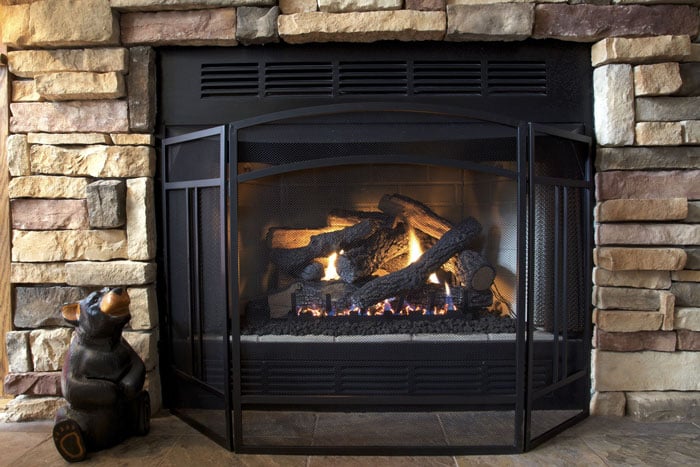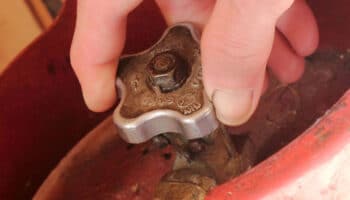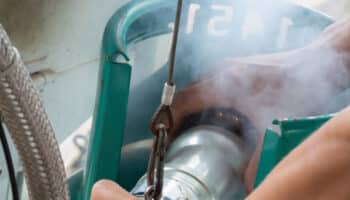We've independently reviewed this article to make sure it's as accurate as we can make it.
To find out more about our article creation and review process, check out our editorial guidelines.
Your gas fireplace won’t turn off, and the heat is getting out of hand?
Sorry to hear that! You might find comfort in knowing that what you’re currently experiencing is quite common, as it affects thousands of people worldwide daily.

In my experience, when it refuses to turn off, a gas fireplace can present a hazard and use more fuel than it should. But don’t worry; you’ve come to the right place for answers.
Below, you’ll find a list including 3 simple things you can try to discover how to turn off your gas fireplace when the normal method seems to be failing.
It’s important to note the difference between liquid propane gas fireplaces and natural gas fireplaces. One can’t be used in place of the other without adapters, which could be the cause of your issue if the wrong type of fireplace has been installed.
Ready? Let’s dive right in!
Fixing a Gas Fireplace That Won’t Turn Off
Step 1: Turn the Remote to Your Gas Fireplace On
When you’re gas fireplace won’t turn off, my usual advice is to start by checking that the on-off switch on your remote (if you have one) is in the on position. You can also try putting fresh batteries inside the remote.
Provided the remote is ok, please move on to the next step.
Step 2: Turn off the Power Switch
If your gas fireplace still won’t turn off, check its power sources. If your fireplace is connected to an outlet, check the switch to ensure the unit is on. The controller may be on the side of the fireplace or behind a panel in its front.
If there’s no switch, it could be on the wall near your fireplace or elsewhere in the room.
Otherwise, you’ll need to turn off the power to the fireplace in the breaker box. (Note that turning off the breaker box’s power only applies to fireplaces with blower motors or electric pilot lights).
If turning off the power in your gas fireplace does not stop the flame, or if it isn’t connected to electrical power, then move on to the next step.
Step 3: Turn off the Gas Supply From the Source
If your gas fireplace still won’t turn off after checking the on-off switch, the remote control, and the breaker box, you have one option left. You must turn off the gas valve that supplies your gas fireplace.
The gas valve for your fireplace runs into your home via a pipe, just as it would for a gas furnace, gas range, or other gas appliance in your home. A gas valve installed near your fireplace generally turns the gas on and off.
Without such a valve near your gas fireplace, you can turn the gas off in the gas tank if you use propane. Natural gas comes into your home via a meter that should be outside of your house near a wall.
The meter should have an emergency cut-off that will shut off the gas in your home.
Shutting the meter off will likely require a wrench, depending on your meter. Once you cut the gas off at the meter, my usual advice is to call the gas company and ask them to turn the gas back on after you or a technician repair your gas fireplace.
Understanding the Underlying Causes
Now that there’s no more gas flowing into your fireplace, it’s important to understand what might have caused the issue. In most cases, when your gas fireplace won’t turn off, it’s due to either a bad pilot light or a bad regulator.
Pilot Lights
Gas fireplaces use two types of pilot lights to start their flame.:
- Standing pilot lights are always on and are common in older gas appliances. Since standing pilot lights are always on, they continually use a minimal amount of fuel.
- More modern gas fireplaces and appliances use electronic ignition to fire off your gas fireplace. Electronic ignition pilot lights are the opposite of a standing flame pilot, as they’re only on when the fireplace is on. If the pilot continues to be on after you turn the unit off, then you have a problem that you may be handy enough to fix. Otherwise, please get in touch with a professional.
- Faulty pilot units are common and are not difficult to replace if you find bad ones. There are also basic fireplaces that use push-button ignition, which can have its own issues.
Knowing which type of pilot light your gas fireplace uses will help you know whether there should be a constant flame, even when the fireplace is off. Not to mention that having fireplace knowledge can help you diagnose problems sooner.
A Bad Regulator
Suppose your gas fireplace uses a regulator to moderate the pressure of the gas that flows into it. If so, the regulator could cause a flame to continue after you turn off your gas fireplace if it is faulty.
If you think for a moment that the regulator is bad, turn the gas off and call a professional.

Designed to sense when there’s a flame, the regulator could allow gas to leak into your home if it is not working correctly. A pilot that stays lit indicates that a bad regulator may be your problem.
However, even if not lit, a pilot with a bad regulator can emit a small stream of raw propane, or natural gas, into your home, which can be very dangerous.
- A faulty gas regulator can cause the gas pressure to fluctuate, which gives an uneven burn that can cause soot.
- The smell of gas in your house could signal a regulator that needs attention.
- If your fireplace’s flame goes up and down, it could be due to a faulty gas regulator.
- Gas regulators are dated, and you need to replace them every 10 years, whether it’s faulty or not.
- If the regulator has been exposed to moisture, replace it immediately.
What to Do if the Gas Fireplace Pilot Light Won’t Go Out
Even though gas log units are relatively simple and have few moving parts, the parts they do have are critical. Playing around with a gas leak is never safe, and if you think that you have an unsafe condition for a minute, turn off the gas and look at your fireplace.
If the repair is beyond your skill level, call a technician and have it fixed.
If you suspect a leak and are waiting on a technician or planning to fix later, make sure there’s good ventilation until the leak is repaired to avoid exposure to gas.
The pilot light of your gas fireplace is where the gas enters. A standby pilot is supposed to be on continuously and does not require electricity to work.
An electronic pilot, however, is only supposed to be on when you light the fireplace. If the pilot stays on once you turn the fireplace off, you may have a problem requiring a technician.
If you think you have a problem because your gas fireplace won’t turn off, use this list to check the items that could be problematic, and then roll up your sleeves.
Alternatively, you can call a technician who likely has the parts needed for the job and get the job done quickly. Whichever choice you make, do not wait to do repairs if your gas fireplace won’t turn off.
The best practice for furnaces, gas heaters, and gas fireplaces of any type is to have them serviced before the cold season and in the spring when you shut them down. You’ll be less likely to be without heat when you need it most if you do so.
Conclusion
That about sums it up!
When your gas fireplace won’t turn off, it’s understandable that you grow worried and annoyed with every passing minute.
Luckily, as I hope this article has helped you better understand, addressing the most common causes behind a gas fireplace that won’t turn off is often simple and quick. In many cases, something as simple as replacing your remote’s batteries and cutting off the gas supply from the source will do the trick.
Thanks for reading; if this post was useful and informational, please consider checking out our other articles below and subscribing to our newsletter.
Have a great day, and stay warm!
-Craig.








